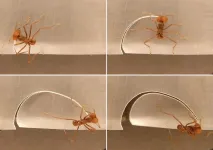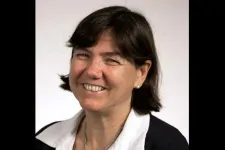(Press-News.org) Influenza A is one of two influenza viruses that fuel costly annual flu seasons and is a near constant threat to humans and many other animals. It's also responsible for occasional pandemics that, like the one in 1918, leave millions dead and wreak havoc on health systems and wider society.
Influenza A was first identified as a health threat nearly a century ago, but only in the last decade have scientists identified one of the virus’s key proteins for infiltrating host cells and short-circuiting their defenses. Now, a team of researchers at the University of Wisconsin–Madison have taken a major step toward understanding how that protein works, with a new finding that runs counter to previous conventional wisdom: They’ve found that viruses like influenza A take over host cells in a way that more closely resembles a tactical strike than brute force.
The protein in question is known as PA-X. It disrupts host cells by degrading their RNA — the genetic material cells need to make proteins for all sorts of purposes, including mounting a defense against invading viruses. PA-X makes thousands of cuts in the RNA of host cells, cleaving the cells' genetic handbook into an indecipherable mess.
But viruses need to deploy this protein while also ensuring their own RNA remains functional. Scientists have been trying to understand how the influenza A virus takes over host cells while minimizing damage to itself. These competing priorities raise a fundamental quandary that gets to the heart of how influenza A has been able to remain such a persistent threat over the eons.
"And that's how the virus is able to mount a surgical strike for the host without messing up its own replication," says Marta Gaglia, an associate professor of medical microbiology and immunology, describing the process by which the virus hijacks host cells to make copies of itself. Gaglia, who led the study, joined the faculty at UW–Madison's Institute for Molecular Virology in 2022.
Using a form of genetic analysis known as high-throughput sequencing and some advanced statistical modeling, Gaglia and her colleagues believe they have cracked at least part of the secret that allows PA-X to degrade host cell RNA without doing too much collateral damage.
"It turns out that PA-X has a strong preference for a very specific sequence of RNA," says Gaglia.
Crucially, Gaglia and her colleagues found that the RNA sequence that PA-X tends to target is very common in the genetic material of humans and other animals infected by influenza A viruses but rarely occurs in the virus's own RNA. And while the protein's aim isn't perfect — it sometimes cuts through non-target RNA sequences — it seems to be good enough to do its job of disrupting the function of host cells. The findings are detailed in a new paper published June 22 in the journal Nature Microbiology.
In addition to identifying the specific RNA sequences that PA-X targets, the study suggests that the influenza A virus has a mechanism for differentiating between RNA sequences in the genetic material of its hosts and itself. This phenomenon, known as self/non-self recognition, is a well-documented part of hosts' immune response to pathogens, but it hasn't before been recognized in viruses.
"It's interesting to see the virus also has found a way to do that, flipping the script," says Gaglia.
Much about the precise function of PA-X remains unknown. Gaglia and her colleagues are looking into whether their current methods adequately capture the position and number of sites in the RNA sequences where PA-X makes its cuts. That work involves fine-tuning the group's statistical models, which are the result of a collaboration with Gaglia's husband, Christopher Rycroft, who is a UW–Madison math professor.
"We've collected some more datasets that we hope to use to refine the methods so we can make this a really robust program that other people can use to analyze their data as well," Gaglia says.
Another open question about PA-X involves its role in the severity of an influenza infection. Previous studies have shown that influenza A strains with a less active PA-X protein are associated with more severe symptoms. But researchers have so far not been able to identify specific genetic hallmarks of a PA-X protein that indicate how active it might be.
"An ideal world that we would like to get to is: If you give me a sequence, I could take a look and say, 'This is a really active version,' or, 'This is a less active version,'" says Gaglia. "And in simplistic terms, that could indicate whether it could be a more dangerous strain."
END
UW–Madison researchers reveal how key protein might help influenza A infect its hosts
Scientists have found that a key viral protein produced by influenza A can shred a host cell's genetic materials while leaving the virus unharmed
2023-06-23
ELSE PRESS RELEASES FROM THIS DATE:
CU professor leads study on discontinuing therapy for MS patients over 55
2023-06-23
AURORA, Colo. (June 22, 2023) – An article published today in the journal Lancet Neurology evaluates the risk of recurrence of active disease in older patients with multiple sclerosis after discontinuing disease-modifying therapies.
Multiple sclerosis (MS) is a chronic illness, often presenting in young adulthood. Most commonly, at onset, individuals have acute attacks, or relapses, of intermittent new neurological symptoms such as vision changes, numbness, and weakness that may come and go, seemingly randomly, and then remit completely or incompletely. ...
Mystery of how leaf-cutting ants gauge leaf portion size revealed
2023-06-23
They might not be able to leap tall buildings with a single bound, but leaf-cutting ants are insect superheroes, capable of carrying leaf pieces up to six times their body mass to cultivate fungus in their borrows. But how do the charismatic creatures determine the size of the fragments they carve with their mandibles? Do they use their bodies as a simple ruler, or do they use information about the position of their bodies to adjust how far they cut, adapting to the thickness of a leaf while dismembering it? Knowing that the insects alter the trajectory of a cut when sculpting ®Parafilm of different thicknesses, Flavio ...
Ramón Barthelemy wins 2023 LGBTQ+ Educator of the Year
2023-06-22
Out to Innovate is proud to announce the winners of its 2023 recognition awards for lesbian, gay, bisexual, transgender, and queer (LGBTQ+) professionals in science, technology, engineering, and math (STEM). Out to Innovate has recognized exemplary individuals with LGBTQ+ Educator, Engineer, and Scientist of the Year for over 15 years.
2023 LGBTQ+ Educator of the Year: Ramón S. Barthelemy, Ph.D
The LGBTQ+ Educator of the Year award recognizes an educator who has significantly impacted STEM students through teaching, ...
Switch to MR angiography for PE mitigated impact of recent contrast shortage
2023-06-22
Leesburg, VA, June 22, 2023—According to an accepted manuscript published in ARRS’ own American Journal of Roentgenology (AJR), preferential use of pulmonary MR angiography (MRA) for diagnosing pulmonary embolus (PE) in the general population helped conserve iodinated contrast media during the 2022 shortage.
“This single-center experience demonstrates use of pulmonary MRA as a practical substitute for pulmonary CTA in emergency settings,” concluded lead investigator Jitka Starekova, MD, from the radiology ...
UW–Madison researchers reveal how the influenza A more effectively infect its hosts
2023-06-22
Influenza A is one of two influenza viruses that fuel costly annual flu seasons and is a near constant threat to humans and many other animals. It's also responsible for occasional pandemics that, like the one in 1918, leave millions dead and wreak havoc on health systems and wider society.
Influenza A was first identified as a health threat nearly a century ago, but only in the last decade have scientists identified one of the virus’s key proteins for infiltrating host cells and short-circuiting their defenses. Now, a team of researchers at the University of Wisconsin–Madison have taken a major step toward understanding how that protein works, ...
Powerful board allies are a CEO's best weapon
2023-06-22
If we’ve learned anything from HBO’s smash hit Succession over the last four years, it’s that, as the authors of a new Strategic Management Journal article state, “Even the most powerful individuals do not work alone.” Given that, whether (SPOILER ALERT!) Tom succeeds in his new role depends less on his business acumen than on who the new CEO has as his allies.
In the upcoming article “Can powerful allies protect the CEO against performance declines? The role of the CEO’s subgroup power in CEO dismissal,” authors Jihae You, Taekjin Shin, and Yunhyung Chung, explore ...
Working toward Black reproductive justice from the Library of Congress
2023-06-22
Historian Tamika Nunley can see the U.S. Supreme Court through the window of her office in the Library of Congress in Washington, D.C., where she is serving as the library’s Cary and Ann Maguire Chair in Ethics and American History this summer. It’s a great vantage point, she said, not only for looking out at landmarks of American government, but also for reflecting on the ways laws and judgements have negatively influenced Black maternal health throughout American history.
“I think the Library of Congress is one of the most democratic institutions we have, one of the best examples of what is possible in our democracy,” said Nunley, ...
Rensselaer researcher uses pressure to understand RNA dynamics
2023-06-22
Just as space holds infinite mysteries, when we zoom in at the level of biomolecules (one trillion times smaller than a meter), there is still so much to learn.
Rensselaer Polytechnic Institute’s Catherine Royer, Constellation Chair Professor of Bioinformatics and Biocomputation at the Shirley Ann Jackson, Ph.D. Center for Biotechnology and Interdisciplinary Studies (CBIS) and professor of biological sciences, is dedicated to understanding the conformational landscapes of biomolecules and how they modulate cell function. When biomolecules ...
New “atlas” maps bacteria and metabolites associated with elevated risk of cardiovascular disease
2023-06-22
CLEVELAND - A Cleveland Clinic research team recently published an “atlas” of metabolites associated with cardiovascular disease in the European Heart Journal. The novel findings provide key details about the routes and potential branching paths taken by bacteria and metabolic by-products, metabolites.
The study mapped out the multiple by-products of bacteria processing amino acids associated with cardiovascular disease and then compared that to patient data to assess disease risk in two large cohorts – one in the US and another in Europe.
Bacteria in and on our bodies produce metabolites through processing certain molecules, referred to as precursors. ...
Brigham researchers identify factors associated with lower breastfeeding duration for mothers with higher BMIs
2023-06-22
A multi-nation cohort analysis found that inflammation and cesarean section delivery in mothers with higher body mass index are connected to shorter duration of breastfeeding, providing potential targets for intervention.
Breastfeeding has significant benefits for both maternal and child health. Research has indicated that women with higher body mass index (BMI) have shorter durations of breastfeeding, but few underlying mechanisms have been identified. To address this gap, a new study led by investigators from Brigham and Women’s ...
LAST 30 PRESS RELEASES:
Interaction of climate change and human activity and its impact on plant diversity in Qinghai-Tibet plateau
From addressing uncertainty to national strategy: an interpretation of Professor Lim Siong Guan’s views
Clinical trials on AI language model use in digestive healthcare
Scientists improve robotic visual–inertial trajectory localization accuracy using cross-modal interaction and selection techniques
Correlation between cancer cachexia and immune-related adverse events in HCC
Human adipose tissue: a new source for functional organoids
Metro lines double as freight highways during off-peak hours, Beijing study shows
Biomedical functions and applications of nanomaterials in tumor diagnosis and treatment: perspectives from ophthalmic oncology
3D imaging unveils how passivation improves perovskite solar cell performance
Enriching framework Al sites in 8-membered rings of Cu-SSZ-39 zeolite to enhance low-temperature ammonia selective catalytic reduction performance
AI-powered RNA drug development: a new frontier in therapeutics
Decoupling the HOR enhancement on PtRu: Dynamically matching interfacial water to reaction coordinates
Sulfur isn’t poisonous when it synergistically acts with phosphine in olefins hydroformylation
URI researchers uncover molecular mechanisms behind speciation in corals
Chitin based carbon aerogel offers a cleaner way to store thermal energy
Tracing hidden sources of nitrate pollution in rapidly changing rural urban landscapes
Viruses on plastic pollution may quietly accelerate the spread of antibiotic resistance
Three UH Rainbow Babies & Children’s faculty elected to prestigious American Pediatric Society
Tunnel resilience models unveiled to aid post-earthquake recovery
Satellite communication systems: the future of 5G/6G connectivity
Space computing power networks: a new frontier for satellite technologies
Experiments advance potential of protein that makes hydrogen sulfide as a therapeutic target for Alzheimer’s disease
Examining private equity’s role in fertility care
Current Molecular Pharmacology achieves a landmark: real-time CiteScore advances to 7.2
Skeletal muscle epigenetic clocks developed using postmortem tissue from an Asian population
Estimating unemployment rates with social media data
Climate policies can backfire by eroding “green” values, study finds
Too much screen time too soon? A*STAR study links infant screen exposure to brain changes and teen anxiety
Global psychiatry mourns Professor Dan Stein, visionary who transformed mental health science across Africa and beyond
KIST develops eco-friendly palladium recovery technology to safeguard resource security
[Press-News.org] UW–Madison researchers reveal how key protein might help influenza A infect its hostsScientists have found that a key viral protein produced by influenza A can shred a host cell's genetic materials while leaving the virus unharmed



